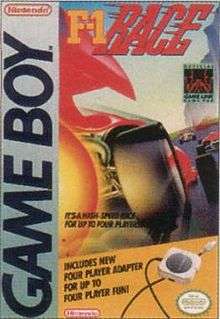F-1 Race
| F-1 Race | |
|---|---|
 Game Boy cover art | |
| Developer(s) |
HAL Laboratory (NES) Nintendo R&D1 (Game Boy) |
| Publisher(s) | Nintendo |
| Composer(s) |
Hideki Kanazashi (NES) Ryoji Yoshitomi (Game Boy) |
| Platform(s) |
Family Computer Game Boy |
| Release date(s) |
|
| Genre(s) | Racing |
| Mode(s) |
Single-player Multiplayer (1-4 players) |
F-1 Race (F1レース F1 Rēsu) is a racing video game released in 1984 for the Family Computer in Japan. A version was released in 1990 for the Game Boy in Japan and in 1991 in Europe and North America, which included the Four Player Adapter for four player gameplay.
Gameplay
The game features racing in one of two Formula One cars around a variety of tracks near world capitals and landmarks. In the Family Computer version of the game, the cars come in three colors: red, light orange, and dark blue.[1]
Gameplay is similar to that of Namco's Pole Position. Finishing in first, second, or third results in a podium finish; players must win on each track to advance to the next. Vehicles in the game have a generic two-speed manual transmission governing their speed (with a "LOW" setting and a "HI" setting).[2] There are ten tracks in the race; the game repeats itself after the conclusion of the tenth circuit.[2] Three difficult levels help beginners to adjust to the artificial intelligence on "skill level 1" while novices get some extra challenge on "skill level 2" and experts get the ultimate challenge on "skill level 3.[2]" A strict time limit forces players to finish races without mistakes in order to progress to a more complicated race track.
Several Nintendo characters appear at the end of race circuits for the Game Boy version: Mario, Luigi, Princess Peach, Toad, Bowser, Link, Samus, Pit and Donkey Kong. The game resulted in a Grand Prix series sequel, featuring Famicom Grand Prix: F-1 Race and Famicom Grand Prix II: 3D Hot Rally. Similar to the original, both games were never released outside Japan.
The Game Boy version has a considerably different gameplay compared to the original version, with all-new circuits set in different countries and new driving mechanics that allows the player to use a limited number of "Jets" to get a speed boost by pressing and holding up on the D-pad (this replaces the low-high gear setting from the original). In addition, the player is able to powerslide by keep holding left or right when turning over sharp corners.
In the Famicom version, the driver of the car is unknown, but it is possible that the driver is Mario, as implied in its sequels.
Clones or hacks
F-1 Race has been cloned on many Famiclone consoles like the N-Joypad Plug and Play console or the Dendy Junior. Clones of the game are listed below: (This may not a complete list.)
- UFO Race: Cars replaced with poorly-modeled UFOs and changed graphics and music.
- Boat Race: Cars replaced with boats and graphics are changed but sound is normal.
- Bicycle Race: Cars replaced with bicycles with all graphics and sound effects are changed. Also, the speed number is divided by 10 from the original (example: 200 km/h changed to 20 km/h).
- Car Race: The name is changed, but the rest is unchanged.
Adaptations
- F-1 Race was one of the videogames based for Manga titled Famicom Rocky published by Comic Coro Coro from 1985 to 1987.
Reception
GamesRadar ranked it the 49th best game available on the Game Boy and/or Game Boy Color. The staff called it a "first-class racing game" and praised its wide appeal to racing fans.[3]
See also
- Mach Rider, another game which shares the same mechanics.
- Famicom Grand Prix: F-1 Race
- Mario Kart
- Pole Position
References
- ↑ Images of F-1 Race for the Family Computer at Retro Game Zone
- 1 2 3 Basic game summary at Xrea
- ↑ "Best Game Boy games of all time". GamesRadar. 2012-04-16. Retrieved 2013-12-05.